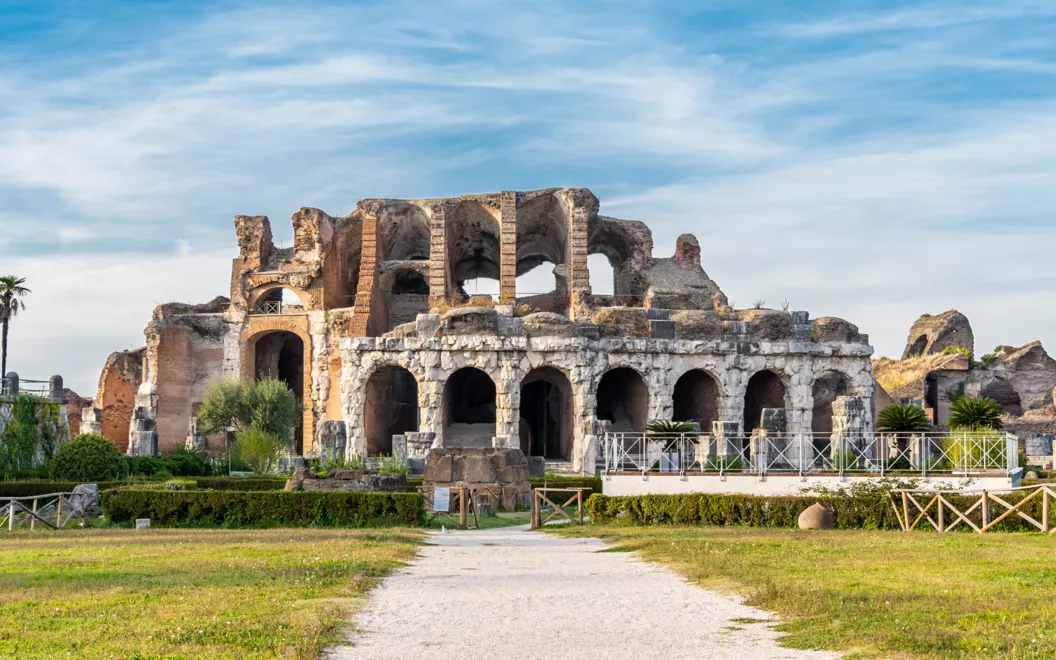Seventh stage of the Giro d'Italia 2023: From Capua to Gran Sasso
2 minutes
Here we are in Capua to begin this seventh stage of the Giro d 'Italia. A city of ancient origins, it was rebuilt in the year 856 following the destruction of "Capua Vetere" by the Saracens. With the arrival of the Normans and with Frederick II of Swabia, the city became an important administrative centre and with the Anjou presence, it was enriched with noble palaces and religious buildings.
Capua encapsulates centuries of history within a few hundred metres: churches ranging from the Lombard period to the late Baroque, Roman antiquities and palaces. The Benedictine Basilica of Sant'Angelo in Formis, with its frescoes, testifies to the high cultural level of the city surrounded by the Volturno river, guarded by Mount Tifata and protected by a powerful wall.
The Campanian Provincial Museum of Capua, is worth a visit, home to many important finds from pre-Roman times to the works of the 18th century, as well as the largest collection of Matres Matutae, statuettes depicting the Roman deity of the morning (or dawn). In fact, in the ancient city of Santa Maria di Capua Vetere, a short distance from Capua, you can still see the majestic ruins of the temple dedicated to the goddess.
The richness of Capua and its surrounding area is echoed by the delicacies of a fertile and flourishing land: buffalo mozzarella, melons, artichokes and cheeses, as well as Casavecchia and Pallagrello wines, are just some of the products of this ancient land.
Before leaving Campania, we must mention the nearby Caserta, with its beautiful old town, a medieval village of great charm, and the splendid Reggia, a UNESCO heritage site, with its wonderful park, the 1752 work of the architect Luigi Vanvitelli, historically belonging to the Bourbon family.
Leaving Capua, the route passes through Molise through the magnificent town of Venafro, which, which, with its urban design, echoes the layout of the ancient Roman settlement, and then arrives in Abruzzo.
On arrival in Abruzzo, a visit to the sixteenth-century Castle of L'Aquila, home of the Munda, is recommended, the National Museum of Abruzzo, where you can see with your own eyes the perfectly preserved skeleton of a mammoth, found in the basin of the ancient lake in 1954.
A rugged and barren terrain then leads us to Roccaraso and, passing through Sulmona, which is famous for its sugar-coated almonds, we reach the 1,190 metres of Calascio, the gateway to the Gran Sasso and Monti della Laga National Park. From here, the view sweeps from the Valle del Tirino to the Navelli plain, admiring a breathtaking panorama. The park lends itself to different activities: from excursions along the various dedicated routes, on foot, on horseback or by mountain bike, to food and wine tours.
The local oil and, above all, saffron have made these places famous; otherwise, they are mostly dedicated to sheep farming.
With another bit of effort, and along a hard and steep road, we climb up to the 2,130 metres of Campo Imperatore, where we can enjoy a well-deserved rest, perhaps enjoying the famous Castel del Monte canestrato, the award-winning pecorino hard cheese, a slow food product.
The stage podium
Chef Enrico Croatti's buffalo mozzarella to savour Campania, Molise and Abruzzo
Buffalo mozzarella is a quintessential food of Campania's gastronomic tradition, which can be enjoyed at any time and in any season.



